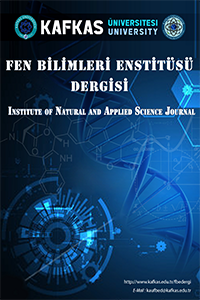Bazı Açilamidrazon ve 1,2,4-Triazol Türevleri için pKa tayini
Bu çalışmada yedi adet 2 adet açilamidrazon ve 5 adet 1,2,4-triazol türevinin asitlik özellikleri incelenmiştir. Bu çalışma susuz ortam olarak amfiprotik çözücülerden izopropil alkol, tert‐butil alkol ve etil alkol kullanılmıştır. Bileşikler tetrabutilamonyum hidroksidin (TBAH) izopropil alkoldeki çözeltisi ile titre edilmiştir. Titrimetrik analizlerde dönüm noktasının belirlenmesinde potansiyometrik metod, asitliğin belirlenmesinde yarı nötralizasyon metodu kullanılmıştır. Titrasyon sonucunda elde edilen sonuçlar tablo ve grafikler halinde verilmiştir. Grafikler incelendiğinde S şeklinde tipik titrasyon eğrileri elde edildiği görülmüştür. Elde edilen veriler ve grafikler kullanılarak bileşiklerin çözücülerdeki asitlik sabitleri hesaplanmıştır. Elde edilen sonuçlara göre bileşiklerin pKa değerleri çözücülerde farklandırıldığı belirlenmiştir. Bu bileşiklerin değişik çözücülerdeki asitlik kuvvetleri çözücünün dielektrik sabiti, otoprotoliz sabiti ve seviyeleme‐farklandırma etkileri incelenmiştir.
Anahtar Kelimeler:
Amfiprotik çözücü, Potansiyometrik titrasyon, Yarı Nötralizasyon metodu
Determination of pKa Values for Some Acylamidrazone and 1,2,4-Tiazole Derivatives
The acidic properties of two acylamidrazone and five 1,2,4-triazole derivatives were investigated. In this study, isopropyl alcohol tert‐butyl alcohol and ethyl alcohol were used among the amphiprotic type in nonaqueous media. Compounds were titrated with tetrabuthylamonnium hydroxide (TBAH) in isopropyl alcohol and titrimetric analyses were used potentiometric method determining the end-points, halfneutralization method determining acidity. The results obtained from the titrations are presented in table and graphs. Typical S‐shaped titration curves were observed in the graphs.The acidity constants of the compounds in the solvents chosen were calculated using the graphs and the data obtained. The pKa values of the compounds were observed to differ from the information obtained. The acidity strength of the compounds with varying R groups in different solvents, dielectric constant of the solvents, autoprotolysis constant and leveling‐differentiation effects were investigated.
___
- Bahçeci Ş, Yüksek H, Ocak Z, Köksal C, Özdemir M 2002. Acta Chim. Slov., 49, 783.
- Bahçeci Ş, Yüksek H, Serdar M 2005. Indian J. Chem., 44B, 568-572.
- Donald JP, Clyde WF 1979. Analytical Chemistry, Second Edition, Academic Press Inc. LTD, London.
- ISSN: 2587-2389
- Yayın Aralığı: Yılda 2 Sayı
- Başlangıç: 2008
- Yayıncı: Kafkas Üniversitesi
Sayıdaki Diğer Makaleler
Songül ULUFER, Özlem GÜRSOY-KOL, Haydar YÜKSEK, Murat Tolga KAYALAR
Bitkilerde Kullanılan Mutajenite Testleri
Bazı Açilamidrazon ve 1,2,4-Triazol Türevleri için pKa tayini
Haydar YÜKSEK, Şule BAHÇECİ, Zafer OCAK, Muzaffer ALKAN, Babir TAĞIYEV, Murat Tolga KAYALAR
Mustafa SERTÇELİK, Hacali NECEFOĞLU
